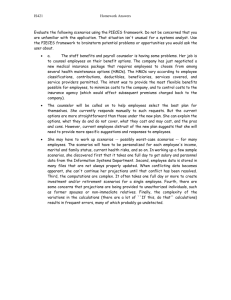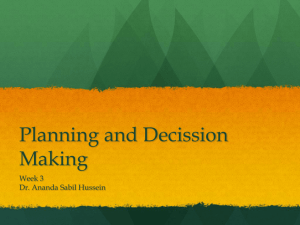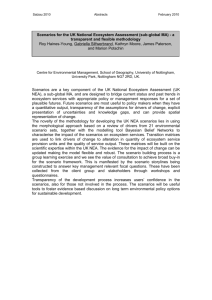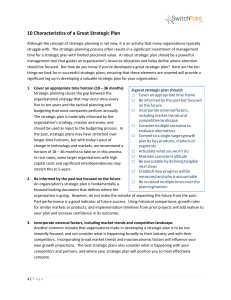Climatic Change
advertisement
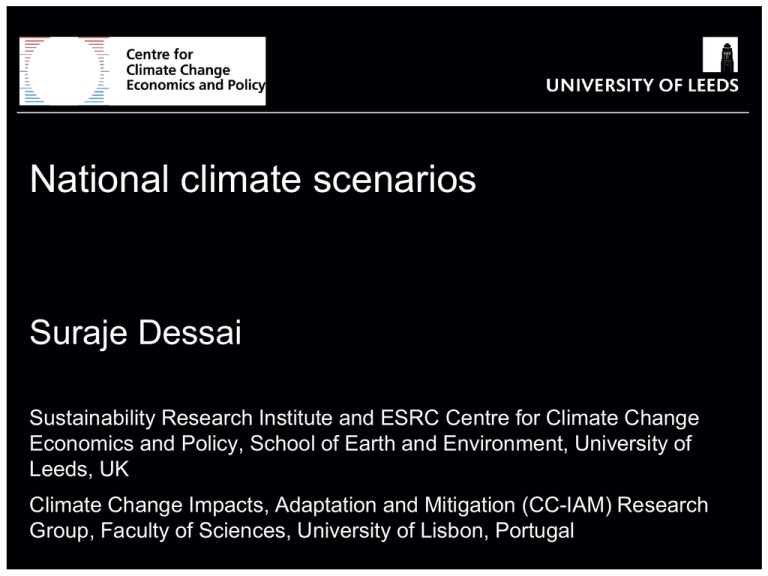
School of something FACULTY OF OTHER National climate scenarios Suraje Dessai Sustainability Research Institute and ESRC Centre for Climate Change Economics and Policy, School of Earth and Environment, University of Leeds, UK Climate Change Impacts, Adaptation and Mitigation (CC-IAM) Research Group, Faculty of Sciences, University of Lisbon, Portugal Outline • Rationale for climate scenario construction • The UK experience of national climate scenarios • Re-thinking national climate scenarios workshop Scenario and climate scenarios 1950s – usage in military strategy and planning 1970s – usage in the energy business (Royal Dutch/Shell; Van der Heijden, 1997). 1980 – first climate scenario (Wigley et al. 1980) Scenarios and climate scenarios 1950s – usage in military strategy and planning 1970s – usage in the energy business (Royal Dutch/Shell; Van der Heijden, 1997). 1980 – first climate scenario paper (Wigley et al. 1980) 1980s-90s – scientific papers and policy documents use and develop climate scenarios 1990s – first national climate scenarios published (UK) 2001 – IPCC TAR WG1 devotes a chapter to the science of climate scenario construction (Mearns et al., 2001) 2009 – first probabilistic climate change projections published (UK) Climate scenario definition A plausible and often simplified representation of the future climate, based on an internally consistent set of climatological relationships that has been constructed for explicit use in investigating the potential consequences of anthropogenic climate change, often serving as input to impact models. Climate projections often serve as the raw material for constructing climate scenarios, but climate scenarios usually require additional information such as the observed current climate. A climate change scenario is the difference between a climate scenario and the current climate (IPCC AR5 WG1) Climate scenarios • Types: synthetic (arbitrary), analogues (temporal and spatial), model based (GCMs, RCMs, statistical, etc.) and hybrids. Climate ‘relocation’ of European cities CNRM ARPEGE-Climat model Hadley Centre HadRM3H model 2080s under SRES A2 scenario Hallegatte et al.(2007) Using climate analogues for assessing climate change economic impacts in urban areas. Climatic Change 82:47–60 National climate scenarios • Climate scenarios are negotiated amongst various actors (Hulme and Dessai, 2008) • Multiple functions: pedagogic, motivational or practical • Often endowed with governmental authority to inform decisionmaking • Increasingly used to inform adaptation A chronology of UK climate scenarios Climate change act UKCP09 projections 2009 COP-15 fails to agree a post 2012 regime A chronology of UK climate scenarios CCIRG91 CCIRG96 UKCP09 UKCIP98 UKCIP02 UK climate scenarios (Hulme and Dessai, 2008) Chronology of estimates of summer precipitation change (%) for the southeast of England UKCIP02 UKCP09 projections • First projections designed to treat uncertainties explicitly (Murphy et al. 2009) • More informative but also more complex than previous scenarios (Murphy et al. 2009) • Designed to inform adaptation decisions • Cost £11 million • User Interface • Reviewed by Steering and User group and 5 experts From UKCIP02 to UKCP09 UKCP09: sampled uncertainties UKCP09 UKCP09 uncertainties • Modelling uncertainty – arising from incomplete understanding of the climate system, and our inability to model it perfectly (PPE: model parameters, the sulphur and carbon cycles) • Natural climate variability – arising from both internal and external factors on the climate system • Emissions uncertainty – arising from not knowing the amount of future global greenhouse gas emissions • Contributions to uncertainty from downscaling UKCP09 map Contributions to the uncertainty in winter precipitation changes for 2070-2099 relative to 19611990, at selected 25 km grid squares. Figure 4.4: 10, 50 and 90% probability levels of changes to the average daily mean temperature (ºC) of the winter (upper) and summer (lower) by the 2080s, under Medium emissions scenario. Figure 4.10: Changes in annual (top), winter (middle) and summer (bottom) mean precipitation (%) at the 10, 50 and 90% probability levels, for the 2080s under the Medium emissions scenario. The greatest difference between UKCIP02 and UKCP09 Demand for climate scenarios • Early mainstreaming into planning (e.g., water resources in late 1990s) now more diverse • Success of UKCIP (1997-) • Research demand (e.g., ARCC programme, 2007-17) • Climate Change Act (2008) • Adaptation Reporting Power (2009): “The UKCP09 Projections are likely to be a useful tool for some organisations in undertaking assessments of their risks from climate change. They will allow decision makers to consider a range of possible future climates, as well as an estimate of the uncertainties surrounding those changes.” (Defra, 2009, p. 8). • Climate change risk assessment (2012) Prevalence of UK national climate scenarios in the academic literature 45 40 35 30 25 UKCIP98 UKCIP02 20 UKCP09 15 10 5 0 2000 2001 2002 2003 2004 2005 2006 2007 2008 2009 2010 2011 2012 2013 2014 Number of peer-reviews papers that include a UK national climate scenario in the topic (includes title, abstract and keywords). Searched in Scopus (24 July 2014). (Re)Thinking National Climate Scenarios Workshop – Dec 2013 • Some research on the construction of UK climate scenarios (Hulme & Dessai, 2008) and its use (Tang & Dessai, 2012) but much remains unclear or undocumented • An international comparison has never been done (to my knowledge) • Aims and objectives of the workshop: • Reflect on the process of national climate scenario construction • Understand what lessons can be learnt about the social, political and technical issues that shaped the construction of national climate scenarios • Think and discuss the next generation of national climate scenarios A chronology of selected national climate scenarios National climate projections in Europe Slide by Stefan Fronzek: adopted from Füssel (2014), in Capela et al. (eds.) Adapting to an Uncertain Climate – Lessons from Practice Some reflections • Tension: “Keep the methodology understandable” vs “Take full advantage of new science and tools” • Separate development and delivery as far as possible (publishing methodology/external review) • Plan strategically for product support and development (It’s a Climate Service) • Keep the rigour on uncertainties, but provide a more flexible set of storylines as a front-line product • Tension: Balance user needs against what science can credibly provide • Keep things simple: unless additional complexity adds value • Fitness-for-purpose • • “credibility”: are the scenarios plausible, authoritative and consistent? • “relevance”: do the scenarios fulfill the user needs? • “legitimacy”: are the scenarios constructed in a transparent way? XXXX does not (yet) provide actionable climate information Treatment of uncertainty Variety of approaches: PPE, MME, statistical emulators, scenarios Relevant Dominant Uncertainty (RDU): is the source of uncertainty or error that is the primary limit on the fidelity of our probability forecasts Communicating Immature Probability forecasts will carry less risk to the credibility all science-based decision support when the RDU is discussed and your Probability of a Big Surprise is provided, explicitly. Why communicate an immature PDF at all? (Lenny Smith) Volunteer computing: almost limitless computer power (weather@home) Hierarchy of approaches needed, but connected Use of scenarios/projections in decision-making Various UK examples of use: water resources planning, Climate Change Risk Assessment (CCRA), energy, etc. User: “we need national climate scenarios less than we think we do”; vulnerability-led approach. Normal range Possible changes outside of the range considered in the CCRA Natural variability Sea Level Rise Increasing uncertainty Climate change* LE(p10) 8 mm Lower ME(p50) HE(p90) 43 mm Central H++ ~ 2m Upper Risk magnitude Decrease No change Increase Where Are We Headed? Generic scenarios are inherently limited – shouldn’t expect too much – modesty/humility Focus more on process and insight rather than model and predictions National Centre for Climate Services – tailoring; where is the boundary between public and private? Early days for decadal predictions (experimental – need to be skilful and reliable) Define a climate science agenda that begins with national vulnerabilities (narrative will help) Are PDFs inherently dangerous? Extras Answers to the questions by one participant • What kind of uncertainty can or should be quantified? • Identify what uncertainty becomes important at what scales but • Internal variability, structural, parameter, inadequacy, predictability, implementation • Does the representation of uncertainty in climate models encounter unique epistemic/technical challenges? • Not unique, potentially most important • Epistemic – need to increase awareness that this is unavoidable (does Gödel’s incompleteness theorem apply here?) • Technical – no, but just about the hugest out there Answers to the questions by one participant • What are the limits to modelling uncertainty? • Can’t do anything about models being wrong • More important are the technical limits • But may not need “the works” depending on application • Data! • Were (are?) simpler approaches possible? • Identify the plausible & the potentially important • Refuse to be precise / design to fail? • Is consistency across scenarios needed? • Some would help • More important is compatibility and comparability
